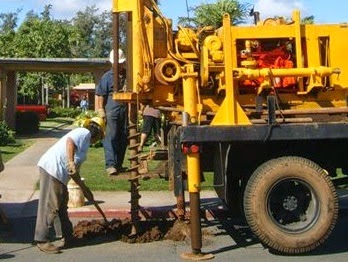I'm always interested in the differences between environmental consulting and other common industries for geologists, such as oil&gas or mining. A comment on this post reminded me that for all my discussions about shoes, I haven't mentioned what's actually required in the environmental business. Short answer: it depends.
The minimum standard is steel-toe boots. I worked for one organization that required steel shanks as well, which put all those Dr. Martens I like so much out of contention. I haven't run into metatarsal-protecting requirements for myself (particularly ugly example here) although I know some health and safety folks who have a pair tucked away. Often reimbursement requires proof that the boots meet ANSI standards.
I often see steel-toe other things in stores and on websites. Steel-toe sneakers. Steel-toe clogs (!?). Steel-toe dress shoes. In the environmental business, you need to have lace-up boots. Some organizations are more or less picky about ankle support, but generally low-cut boots are frowned on. A drilling location at an environmental site is generally comparable to an early-phase construction site, with lots of hoses lying around, vehicles coming in and out, uneven terrain, and mud or dust. The primary hazard is vehicular and slip-trip-fall. Worst-case scenario, you need the ability to skedaddle, and slip-on shoes don't help.
If you're doing mud-rotary or air-rotary drilling and there's potential to be standing in potentially contaminated gack, the number one way to limit exposure is to not be standing in it. The only person who should be in there is the helper(s) who are mucking out the mud tub. In those cases, the helper will often wear a pair of steel-toe rubber boots. Usually the driller stands on a little fold-out platform at the controls (see below, from here) and only rarely has to stand in the cuttings.
With that said, steel-toe rubber boots are a good back-up in certain situations: They can help in the winter if you're
going to be standing in a snowbank or a puddle of slush all day. They're also useful if you find yourself in a truly hazardous or gross material and you need to decontaminate your boots. For example, when I was trying to add enough extra bentonite and wood shavings to stabilize a roll-off container of contaminated slop so that it could be picked up by the hauler without sloshing out the back. Standing in a roll-off box and smushing wood shavings into slop by standing on a pile and kicking it around is not my finest moment.
To sum up: lace-up, over the ankle steel toe boots! Unless sloppy mess, in which case rubber boots are ok. Maybe. It can be complicated out there.
Tuesday, May 20, 2014
Subscribe to:
Post Comments (Atom)


1 comment:
The steel-toed dunlop volleys are used by roofers. They complained that ANSI-certified boots were too slippery in the rain, their supervisors went apeshit over the soft toed shoes, and eventually somebody realized there was a market there.
Post a Comment